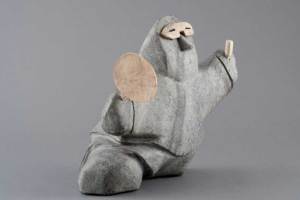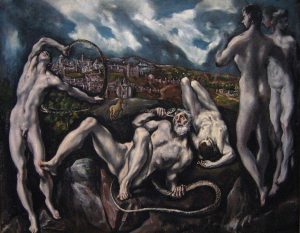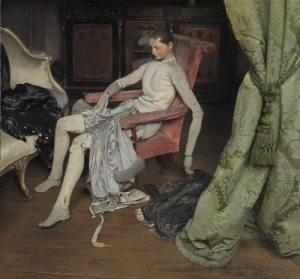For each of the 12 days of Christmas we have asked Apollo staff and contributors to select the artistic highlights that they are most eagerly anticipating in 2014. The Muse Room will return with its regular daily blogs on 7 January 2014. From all of us at Apollo, happy new year!

Drum Dancer (1987), Thomas Akilak © Scott Polar Research Institute. Photo: Martin Hartley
Two Temple Place reopens its doors in January for an exhibition of ‘Discoveries’ from the University of Cambridge Museums. The themes of ‘Art, Science and Exploration’ are ambitiously broad, but instead of a sweeping historical narrative, visitors will be treated to a series of bizarre anecdotes and curious objects, such as the Tinamou Egg from the HMS Beagle, which Darwin accidentally cracked. In its fittingly eclectic late-Victorian venue, it should be an enjoyable wunderkammer of a show.

Laoconte (c. 1610–1614) El Greco, Washington DC, National Gallery of Art. Samuel H. Kress Collection
In Spain, the Prado’s major summer exhibition ‘El Greco and Modern Painting’ marks 400 years since the artist’s death, and examines how various artists of the 19th and 20th centuries adopted him as a proto-modernist. The strength of the Prado’s collection of El Greco paintings alone suggests it will be an excellent show, but its prelude, opening at the end of March, will perhaps offer a more interesting perspective on the artist. ‘El Greco’s Library’ examines his literary and theoretical sources, presenting him as a product of his own time rather than a prophet of another, in an unusual inversion of the familiar narrative.

Reposing (c. 1929), Alan Beeton © The Fitzwilliam Museum, University of Cambridge
Finally, the Fitzwilliam Museum’s ‘Silent Partners’ exhibition has a fascinating premise for a major historical show. It traces the changing use of the artist’s mannequin, from a simple studio tool, to an object of fetish, to a subversive art object. Packed with unusual exhibits from the edges of art history, it could elevate the man-made human doppelganger from an interesting art-historical footnote to a subject in its own right.
‘Discoveries: Art, Science and Exploration from the University of Cambridge Museums’ is at Two Temple Place, London, from 31 January–27 April 2014.
‘El Greco’s Library’ is at the Museo Nacional del Prado, Madrid, from 31 March–29 June 2014, and ‘El Greco and Modern Painting’ is open from 24 June–5 October 2014.
‘Silent Partners: Artist and Mannequin from Function to Fetish’ opens at the Fitzwilliam Museum, Cambridge, in October 2014.

12 Days
Share
For each of the 12 days of Christmas we have asked Apollo staff and contributors to select the artistic highlights that they are most eagerly anticipating in 2014. The Muse Room will return with its regular daily blogs on 7 January 2014. From all of us at Apollo, happy new year!
Drum Dancer (1987), Thomas Akilak © Scott Polar Research Institute. Photo: Martin Hartley
Two Temple Place reopens its doors in January for an exhibition of ‘Discoveries’ from the University of Cambridge Museums. The themes of ‘Art, Science and Exploration’ are ambitiously broad, but instead of a sweeping historical narrative, visitors will be treated to a series of bizarre anecdotes and curious objects, such as the Tinamou Egg from the HMS Beagle, which Darwin accidentally cracked. In its fittingly eclectic late-Victorian venue, it should be an enjoyable wunderkammer of a show.
Laoconte (c. 1610–1614) El Greco, Washington DC, National Gallery of Art. Samuel H. Kress Collection
In Spain, the Prado’s major summer exhibition ‘El Greco and Modern Painting’ marks 400 years since the artist’s death, and examines how various artists of the 19th and 20th centuries adopted him as a proto-modernist. The strength of the Prado’s collection of El Greco paintings alone suggests it will be an excellent show, but its prelude, opening at the end of March, will perhaps offer a more interesting perspective on the artist. ‘El Greco’s Library’ examines his literary and theoretical sources, presenting him as a product of his own time rather than a prophet of another, in an unusual inversion of the familiar narrative.
Reposing (c. 1929), Alan Beeton © The Fitzwilliam Museum, University of Cambridge
Finally, the Fitzwilliam Museum’s ‘Silent Partners’ exhibition has a fascinating premise for a major historical show. It traces the changing use of the artist’s mannequin, from a simple studio tool, to an object of fetish, to a subversive art object. Packed with unusual exhibits from the edges of art history, it could elevate the man-made human doppelganger from an interesting art-historical footnote to a subject in its own right.
‘Discoveries: Art, Science and Exploration from the University of Cambridge Museums’ is at Two Temple Place, London, from 31 January–27 April 2014.
‘El Greco’s Library’ is at the Museo Nacional del Prado, Madrid, from 31 March–29 June 2014, and ‘El Greco and Modern Painting’ is open from 24 June–5 October 2014.
‘Silent Partners: Artist and Mannequin from Function to Fetish’ opens at the Fitzwilliam Museum, Cambridge, in October 2014.
Unlimited access from just $16 every 3 months
Subscribe to get unlimited and exclusive access to the top art stories, interviews and exhibition reviews.
Share
Recommended for you
Apollo Advent Calendar: Day 23
Theo Wormland’s collection of Surrealist art has been on loan to the Pinakothek der Moderne for 30 years. In 2013 it was bequeathed to the museum
12 Days
Hannah Höch, the German Renaissance, and Joana Vasconcelos – three very different, but equally enticing, exhibitions coming up in 2014
Draughtsmen
Masculinity is having a moment. The Wallace Collection’s ‘The Male Nude’ follows the Musée d’Orsay’s lead and takes a closer look at men in art